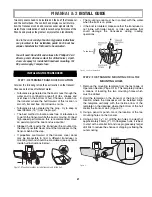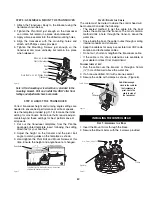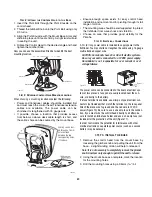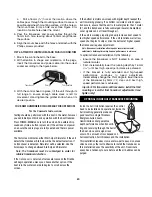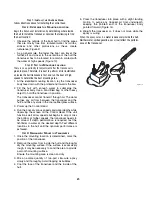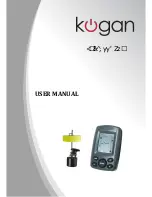
I-3
S
TEP
2: A
TTACH THE
C
ONTROL
H
EAD TO THE
B
ASE
1.
Insert the Pivot Bolt through the Pivot Knuckle on the
control head.
2. Thread the Gimbal Knob onto the Pivot Bolt using only
2-3 turns.
3. Align the Pivot Knuckle with the Mount Base Arms and
slide into place until it seats firmly. A slight twist will aid
in seating the unit.
4. Rotate the Control Head to the desired angle and hand
tighten the Gimbal Knob.
No
w you can use the assembled Piranha to identify the best
mounting location.
S
TEP
3: D
ETERMINE
C
ONTROL
H
EAD
M
OUNTING
L
OCATION
When choosing a mounting loca
tion consider the following:
•
Power and transducer cables should be installed first
and must reach the control head. Transducer extension
cables are available. The power cable can be
shortened or lengthened with 18 gauge wire.
•
If possible, choose a location that provides access
from below so above deck cable length is short, and
the cable’s hole can be covered by the mount base.
•
Ensure enough space exists for easy control head
installation and removal and for pivoting through its full
range of motion.
•
The mounting area should be well supported to protect
the fishfinder from wave shock and vibration.
•
Choose an area that provides good visibility for the
Piranha.
S
TEP
4: E
LECTRICAL
C
ONNECTIONS
A 2m (6’) long po
wer cable is included to supply power to the
fishfinder. You may shorten or lengthen the cable using 18 gauge
multi-stranded copper wire.
CAUTION:
Some boats have 24 or 36 volt electric systems.
Be sure your unit is connected to a 12 VDC power supply.
Humminbird is not responsible for over current or over
voltage failures.
The po
wer cable can be connected to the boat’s electrical sys-
tem at two places: a fuse panel, usually located near the con-
sole, or directly to the battery.
If a fuse terminal is available, use crimp-on type electrical con-
nectors (not included) that match the terminal on the fuse panel.
Attach the black wire to ground and the red wire to 12 VDC
power (Figure 10). Be sure to use a one amp fuse in the connec-
tion. If you must wire the control head directly to a battery, be
sure to install an inline fuse holder and use a one amp fuse (not
included) for the protection of the unit (Figure 11).
In order to minimize the potential for interference with other
marine electronics a separate power source (such as a second
battery) may be necessary.
STEP 5: INST
ALL THE BASE
1.
Remove the control head from the mount base by
loosening the gimbal knob and pulling the unit from the
base - a slight twisting motion will help to release it.
Note:
It is not necessary to completely remove the gimbal
knob. Unscrew only enough to permit the unit to release.
2.
Using the mount base as a template, mark the location
for the mounting holes.
3. Drill the mounting holes using a 3.5mm (
⁹⁄₆₄
") bit.
Figure 8
Pivot Bolt
Pivot Knuckle
Gimbal Knob
Figure 9
Ca
bling can be rout-
ed through a 16mm
hole centered
between the two
rear mounting holes
of the base.
GROUND
POSITIVE
Figure 10
Figure 11

